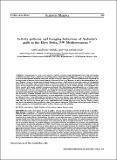Por favor, use este identificador para citar o enlazar a este item:
http://hdl.handle.net/10261/5793COMPARTIR / EXPORTAR:
 SHARE
BASE SHARE
BASE
|
|
| Visualizar otros formatos: MARC | Dublin Core | RDF | ORE | MODS | METS | DIDL | DATACITE | |

| Título: | Activity patterns and foraging behaviour of Audouin's gulls at the Ebro Delta, NW Mediterranean |
Otros títulos: | Patrones de actividad y comportamiento de caza en la gaviota de Audouin en el delta del Ebro, Mediterráneo occidental | Autor: | Oro, Daniel CSIC ORCID CVN ; Ruiz, Xavier; Mañosa, Santi | Palabras clave: | Radiotracking Trawler fisheries Activity patterns Seabird Foraging range Radioseguimiento Pesca de arrastre Patrones de actividad Aves marinas Área de campeo |
Fecha de publicación: | 2004 | Editor: | CSIC - Instituto de Ciencias del Mar (ICM) | Citación: | Sci. Mar. 68(4): 605-614 | Resumen: | [EN] Twenty Audoui´s gulls, Larus audouinii, breeding in the Ebro Delta (NW Mediterranean) were radio-tracked in 1998 to study their foraging behaviour and activity patterns. Some detrimental effects of tagging on the breeding success of the birds were detected, especially when both members of the pair were tagged. The results were actually constrained by the low number of locations due to natural breeding failure and failure in tag emission, as well as the adverse effect of tagging. However, through a combination of aircraft surveys at sea and a fixed station for automatic tracking of the presence of the birds at the colony, novel individual-based information of home ranges and activity patterns was obtained. Trawler fishing activity seemed to influence both the foraging range and habitat use: while trawlers operated, gulls overlapped their fishing grounds with vessels, probably to scavenge on discards. Very few locations were obtained during a trawling moratorium period, although they were all recorded in coastal bays and terrestrial habitats. During the trawling activity period, gulls ranged over a minimum convex polygon area of 2900 km2. Gulls were tracked up to 40 km from the colony, but some individuals were observed beyond 150 km while still breeding. Arrivals and departures from the colony were in accordance with the trawling timetable. However, most birds also showed some nocturnal foraging activity, probably linked to active fishing of clupeoids (following diel migrations) or to the exploitation of purse-seine fishing activity. Foraging trips lasted on average 15 hours: males performed significantly shorter trips than females, which spent more time outside the colony. The proportion of nocturnal time involved in the foraging trips was the same for males and females, but whilst all males initiated their trips both during the day and at night, some females only initiated their trips during the day. Hatching success was found to be related to foraging effort by males. Gulls spent on average ca. 38% of their time budget outside the nesting territory, representing the time devoted mainly to flying, foraging and other activities. [ES] El comportamiento de forrajeo de la gaviota de Audouin Larus audouinii y sus patrones de actividad fueron estudiados en la colonia del delta del Ebro (Mediterráneo noroccidental) mediante el marcaje con radioemisores. Detectamos algunos efectos negativos en la fecundidad de los individuos marcados, especialmente cuando los dos miembros de la pareja portaban radio-emisores. De hecho, los resultados estuvieron limitados por el bajo número de localizaciones debido a los fallos de señal de muchos de los emisores, los fracasos reproductivos y los efectos adversos del marcaje. La actividad de la flota de arrastre pareció influir tanto sobre el área de forrajeo como sobre el uso del hábitat: mientras los arrastreros faenaron, las gaviotas solaparon su actividad trófica con los caladeros de los barcos, muy probablemente para explotar los descartes generados por la flota. Se obtuvieron muy pocas localizaciones durante el periodo de veda de arrastre, pero todas ellas se registraron en bahías costeras y en hábitats terrestres (como los arrozales). Durante el periodo en que los arrastraron faenaron, las gaviotas se movieron sobre un área (método del mínimo polígono convexo) de 2900 km2. Mediante el radioseguimiento, se localizaron gaviotas a 40 km de la colonia, pero algunos individuos fueron observados más allá de los 150 km mientras aún estaban reproduciendose. Las llegadas y salidas de la colonia se solaparon con el horario de los arrastreros. Sin embargo, la mayoría de los animales mostraron también actividad nocturna, probablemente relacionada con el forrajeo natural de pequeños pelágicos (siguiendo las migraciones verticales de estos peces) o la asociación con pesquerías de cerco. Los desplazamientos de forrajeo duraron en promedio 15 horas: los machos realizaron desplazamientos significativamente más cortos que las hembras, que pasaron más tiempo fuera de la colonia. La proporción de horas nocturnas empleadas en el forrajeo no varió estadísticamente entre machos y hembras, pero mientras todos los machos iniciaron sus desplazamientos tanto de día como de noche, algunas hembras sólo partieron de la colonia durante las horas de luz. El éxito de eclosión estuvo relacionado con el esfuerzo de forrajeo de los machos. Las gaviotas emplearon el 38% de su tiempo fuera de la colonia dedicándose a volar, alimentarse y a otras actividades. |
Descripción: | Publicación online disponible en: http://www.icm.csic.es/scimar/index.php | URI: | http://hdl.handle.net/10261/5793 | ISSN: | 0214-8358 | E-ISSN: | 1886-8134 |
| Aparece en las colecciones: | (IMEDEA) Artículos |
Ficheros en este ítem:
| Fichero | Descripción | Tamaño | Formato | |
|---|---|---|---|---|
| ebro.pdf | 246,64 kB | Adobe PDF |  Visualizar/Abrir |
CORE Recommender
Page view(s)
458
checked on 22-abr-2024
Download(s)
235
checked on 22-abr-2024
Google ScholarTM
Check
NOTA: Los ítems de Digital.CSIC están protegidos por copyright, con todos los derechos reservados, a menos que se indique lo contrario.
